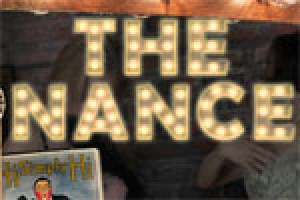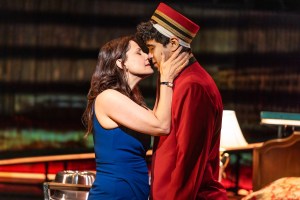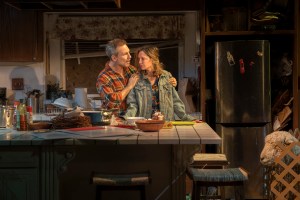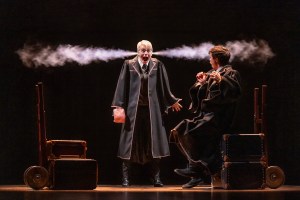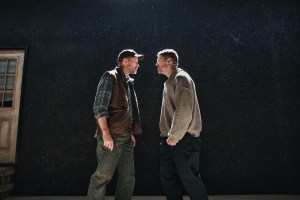
(© Joan Marcus)
The effervescent Jenni Barber made her Broadway debut as the sweet and lonely Olive Ostrovsky in The 25th Annual Putnam County Spelling Bee in 2007. Recently, she did a 180 to star in the short-lived Broadway run of The Performers as busty porn star Sundown LeMay. This month, Barber put her clothes back on just to have the opportunity to take them back off (classily, piece by sequiny piece) as burlesque performer Joan in Douglas Carter Beane’s The Nance.
TheaterMania spoke to Barber about creating her role, acting opposite Nathan Lane, and picking up tips from some of the greatest strippers in the history of burlesque.
How did you become involved with this production?
Before I started rehearsals for The Performers, I was asked to participate in a reading of The Nance. I remember reading the play and thinking “Oh my gosh, this play is so good. I love these characters. And I don’t know if I’m going to be available to even audition for it and be a part of it!”
And right after we found out The Performers was not going to continue, I ended up contacting some of the people at Lincoln Center and saying, ‘If you’re holding auditions, I’m available.’ So it ended up freeing me up to be able to audition again for The Nance.
What has it been like to work with Nathan Lane and so many Broadway vets?
It’s been a dream come true. I’ve admired Cady Huffman and Lewis Stadlen from their work for so many amazing years. And Andréa Burns has been one of my personal heroes since college. I’ve told her, “I used to listen to you in college, in my little dorm room, thinking ‘Oh god, if I could sound like Andréa Burns.'”
And [director] Jack O’Brien, of course, is a University of Michigan grad, as well. He came there [once] and gave this incredible speech that changed my life. And I was like, “OK, I have to work with that man at some point in my life.”
At first, working with Nathan Lane, I think I was probably nervous, thinking, “Oh my gosh, I hope I’m funny enough. He’s the funniest guy of all time,” and, “Oh god, I’m such a hack in comparison.” But he is just so lovely and incredibly generous and very warm and sincere, and so he puts everyone at ease, I think.
What’s your favorite burlesque act in the show?
I think probably the peace-and-quiet burlesque sketch. Watching Lewis Stadlen and Nathan Lane, two pros just go at it, I’m laughing out loud, like, fully, in the wings every night. It’s just a delight. My god, it’s so funny.

What’s your favorite act that you’re a part of?
Surprisingly, some of the smaller, very focused, specific things are very difficult. Joey Pizzi, who’s such an incredible choreographer, did some research that was done on a stripper named Zorita who had done this half bride-half groom thing, and Glen Kelly wrote this beautiful music for it, so it was really collaboration. It was very exciting to create.
It’s very exciting for me [to perform], especially because I can’t see anything. My head is completely covered by the hat. I’m like, I hope this looks good. I have no idea. I hope you guys like it!
Did many of the sketches exist before this show?
They’re all original. Douglas Carter Beane wrote all these sketches. But they’re based on old, old, old, sketches. Nathan Lane makes a joke at one point about “the comedy sensation that came over on the Mayflower.” So I think that a lot of them have been going on since, I don’t know, the 1600s. But they’re all new interpretations.
How much did you know about that era and its political climate before this show?
Not a whole lot, especially, about LaGuardia and his kind of pushing out all the burlesque performers. That is something that Douglas Carter Beane brought to light, and I think a lot of people were surprised. Burlesque has been on all over the country except for New York City. That’s why all these New Jersey cities had these huge, beautiful burlesque theaters. That’s so bizarre and strange, and it was all a political move.
And there was the World’s Fair that happened right after — that had burlesque in it. They sort of figured out how to finagle around those rules. And the World’s Fair in Chicago, which was right before that, in ’33 and ’34, Sally Rand, who’s a very famous burlesque performer. We based some of the fan dance that I do in the show on her. She came to huge fame as a burlesque performer in Chicago. She even got arrested and became even more famous for showing even more of her body. The research about the burlesque performers, for me personally, was really exciting.
Do you have any nostalgia for that period now?
I think it’s really fascinating to see where everybody found their families, even at a time where it was not accepting of people who were trying to live their lives as they are. I’m not sure I’d want to live at that time, though. You know, women could only vote for about twenty years at that time and they were still trying to find their footing.
I think it’s fascinating to see sort of where we’ve come and actually how far we haven’t come. And I really have a respect for the performers of that time and the way that they were able to make a living, especially during the depression. And during a really difficult time when you were just living hand to mouth and to be able to do that, to have some artistic expression during that time period is pretty amazing.


